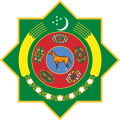Rub el Hizb

The Rub el Hizb (Template:Lang-ar rubʿ al-ḥizb) is a Muslim symbol, represented as two overlapping squares, which is found on a number of emblems and flags. In Arabic, Rubʻ means "one fourth, quarter", while Hizb means a group or party. Initially, it was used in the Quran, which is divided into 60 Hizb (60 groups of roughly equal length); the symbol determines every quarter of Hizb, while the Hizb is one half of a juz'. The main purpose of this dividing system is to facilitate recitation of the Qur'an.
The symbol is used as a marker for the end of a chapter in Arabic calligraphy. It is represented by two overlapping squares as in the Unicode glyph ۞ at U+06DE.
Uses

The Rub el Hizb can be seen on:
- The flag of the Marinid and Saadi dynasties of Morocco
- The current coat of arms of Turkmenistan
- The current coat of arms of Uzbekistan
- Azat party flag [1]
- The unofficial flag of Kazakhstan in the 1990s, the basis of the modern state flag, light blue with a hollow yellow rub el hizb
- The official emblem of the elite Special Police Squad "Bosna" of the Ministry of Interior of the Republic of Bosnia and Herzegovina during the Siege of Sarajevo.
- The fictional flag of Hatay in Indiana Jones and the Last Crusade
- The emblem of the Organization of the Scout Movement of Kazakhstan
- The previous emblem of the Iraq Boy Scouts and Girl Guides Council
- The logo of the Cairo Metro
- The octagonal buildings [2] [3][4]
- Isra and Mi'raj: The meeting of the crescent moon and the star. [5]
The cross-sections of the Petronas Twin Towers are based on the Rub el Hizb, but with extra circular sectors (outlined in red in the image on the right) added to increase the total floor space.
-
Flag of Morocco between 1258–1659
-
coat of arms of Turkmenistan, in use since 2003
-
coat of arms of Uzbekistan, adopted by law on July 2, 1992
-
Azat party flag
-
Kazakhstan Customs flag
-
fictional flag of the Republic of Hatay
-
unofficial flag of Kazakhstan in the 1990s
-
old Moroccan flags, captured by France at the Battle of Isly 1844
-
Ilkhanate "Rub el Hizb" geometrical wall-tile containing the Azure dragon.
Al-Quds star


The al-Quds star (in Arabic نجمة القدس, najmat al-Quds) is an adaptation of the Islamic Rub el Hizb symbol which is specifically associated with al-Quds (i.e. Jerusalem).
The eight-pointed star design is inspired by the octagonal ground-plan of the Umayyad Dome of the Rock shrine (built to commemorate Jerusalem's status as the first Qibla or direction of prayer in Islam), as well as by the standard Rub el Hizb symbol.[citation needed]
Versions of the al-Quds Star are used as:
- The logo of the 2009 Arab Capital of Culture, chosen to be al-Quds, under the Cultural Capitals Program to promote and celebrate Arab culture and encourage cooperation in the Arab region.[citation needed]
- The logo of al-Quds Bank, a financial institution headquartered in Ramallah.
See also
- Star of Lakshmi
- Sujud, which uses the symbol ۩ in most Korans
- List of symbolic stars
- Octagram









